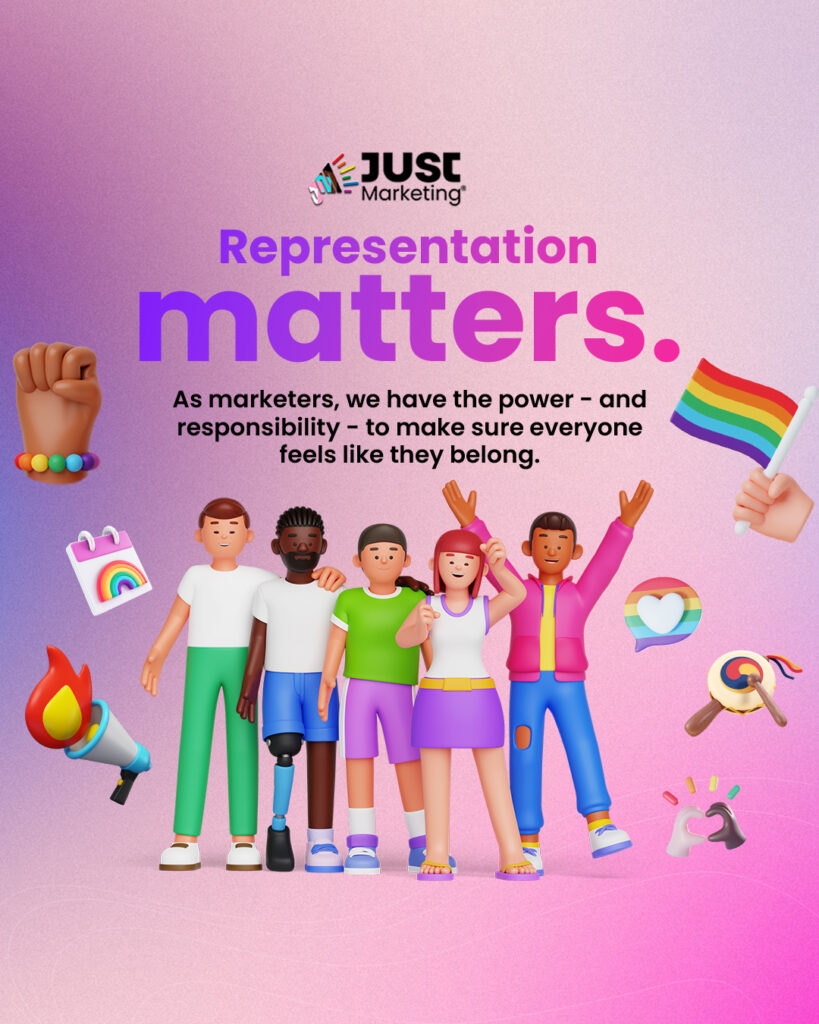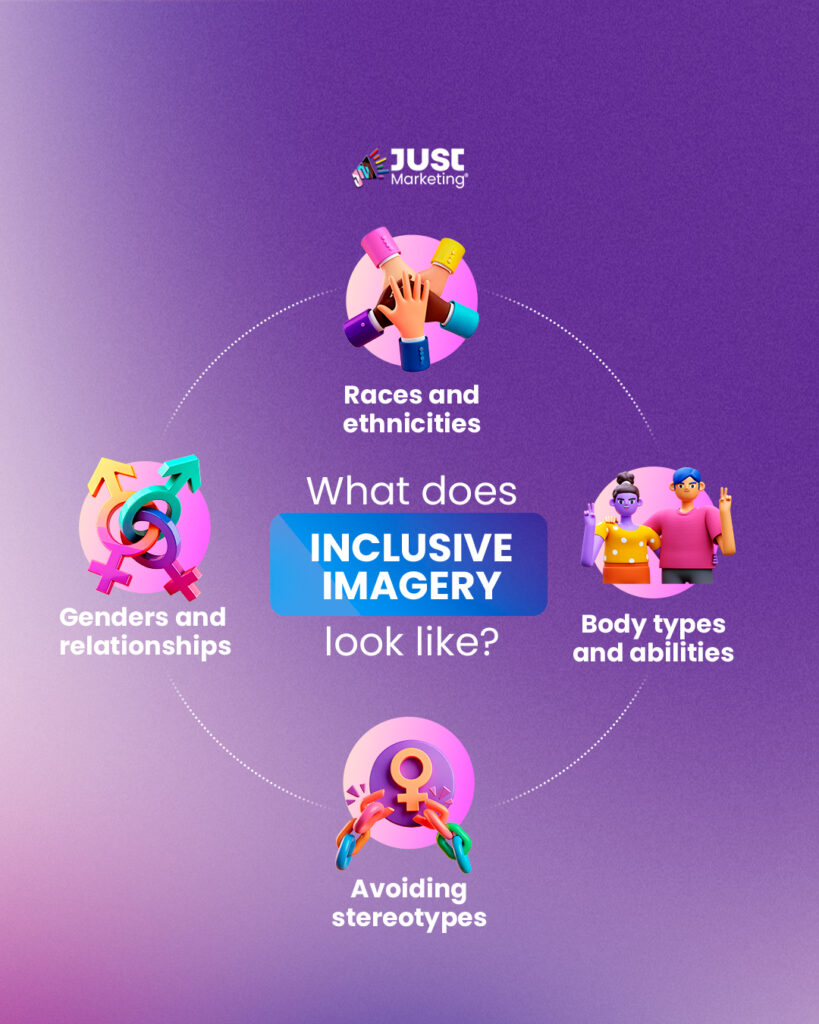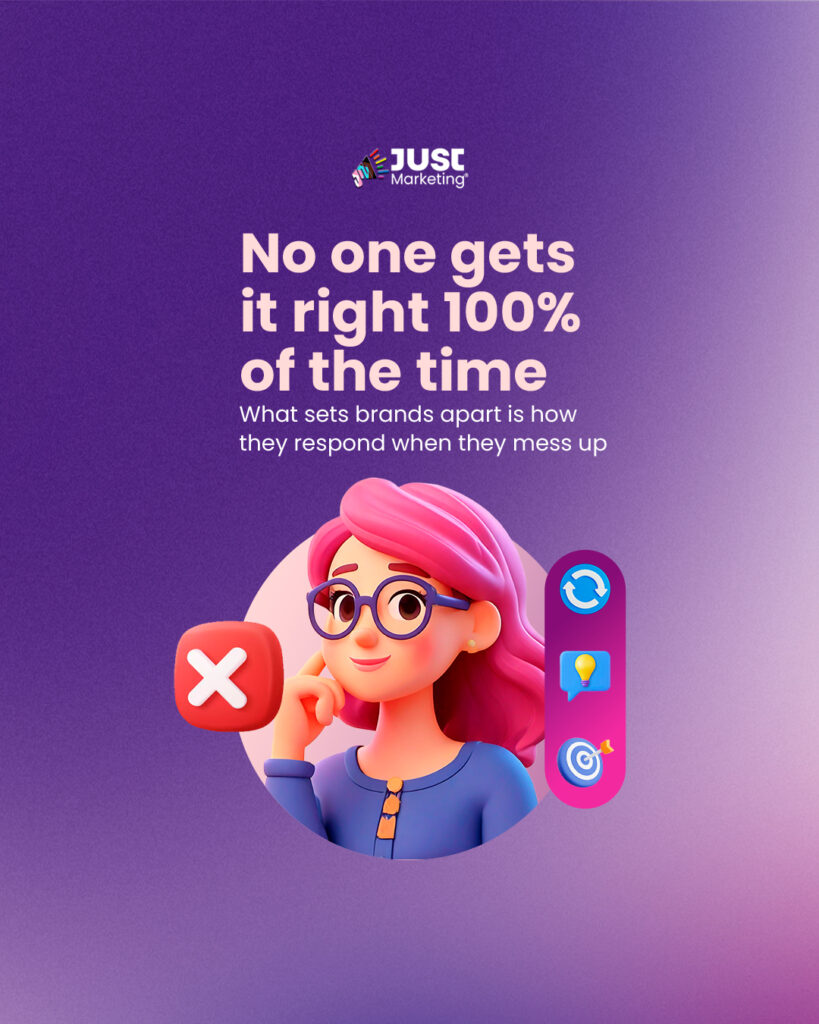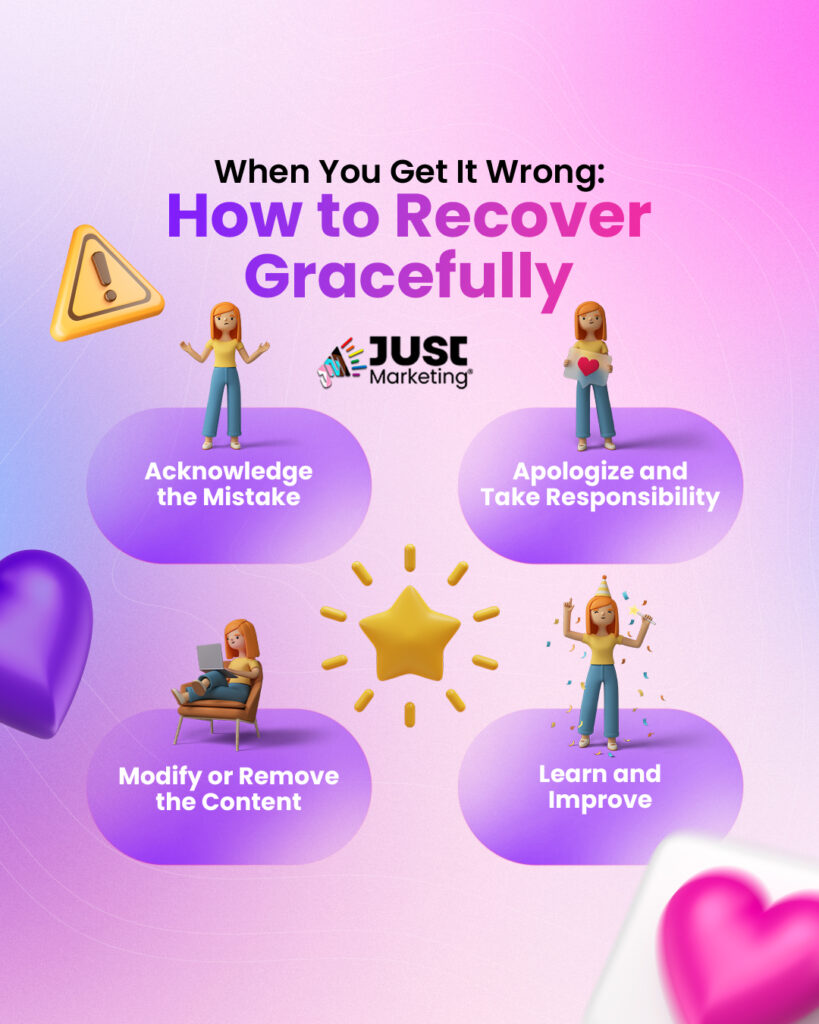The language we use and the imagery we choose in our marketing can either create meaningful connections or reinforce harmful exclusion. Marketing representation is about more than checking a box; it’s about building trust, fostering belonging, and aligning your brand with values that matter.

During a conversation with Jillian Abby – a queer author, storyteller, and marketing expert – we explored the importance of inclusive language and imagery in marketing. Jillian shared her personal journey, her professional insights, and the challenges and triumphs she’s faced as both a business owner and consumer. From shopping for an engagement ring as a same-sex couple to rewriting the rules of inclusive storytelling, her experiences underscore the profound impact of representation.
This blog post builds on key insights from my discussion with Jillian and complements the foundations laid in two previous articles, Why Diverse Imagery in Marketing Matters and How to Use Inclusive Language to Connect with a Broader Audience. Here, we’ll take the conversation further by diving into why marketing representation matters and, most importantly, how to get it right – because when you do, the rewards extend far beyond your bottom line.
The Case for Marketing Representation
When people see themselves represented in marketing, it does more than just grab attention – it builds trust and emotional connection. Marketing representation says, “You belong here. We see you.” In a world where many communities have been historically overlooked or stereotyped, inclusive marketing serves as a powerful tool to challenge biases and foster belonging.

But the benefits of inclusion extend beyond emotional impact. Marketing representation is also a savvy business move. Jillian Abby shared a striking example during our conversation: In 1994, American Airlines launched a campaign specifically marketed toward the LGBTQ+ community. Within five years, their revenue from this segment skyrocketed from $20 million to $193.5 million. The reason? Their marketing made LGBTQ+ customers feel recognized and valued – two factors that foster loyalty.
This phenomenon isn’t limited to one community. According to a 2019 study, LGBTQ+ consumers, for example, control an estimated $3.7 trillion in spending power worldwide. And it’s not just about dollars – 90% of LGBTQ+ consumers prefer to support brands that actively champion their community. The same principle applies to other marginalized groups. When you make an effort to include underrepresented communities, you open the door to not just new customers but lifelong brand advocates.
The Cost of Exclusion
On the flip side, failing to be inclusive – or worse, unintentionally excluding your audience – can damage your brand’s reputation and alienate potential customers. Jillian shared her personal experience of engagement ring shopping as a same-sex couple. Her biggest concern wasn’t the price tag but whether her relationship would be invalidated by the businesses she approached. Before choosing a jeweler, Jillian scrutinized websites and social media accounts for signs of inclusivity.
Her research revealed a glaring gap: while some jewelers used rainbow-themed logos during Pride Month (a common but surface-level nod to inclusivity), few featured same-sex couples in their advertising or used language that acknowledged LGBTQ+ relationships. This exclusion made Jillian, and countless others like her, feel unwelcome – a missed opportunity for those brands to establish trust and gain her loyalty.
Justice-Oriented Marketing: Aligning Values with Action

For mission-driven entrepreneurs, marketing representation isn’t just about expanding your customer base; it’s about living your values. Ethical marketing is a commitment to justice, equity, diversity, and inclusion (JEDI principles). It challenges systemic inequities and creates space for everyone to feel seen and valued.
When you align your brand’s actions with your values, you show your audience that you’re not just here to sell – they know you’re here to make a difference. That’s the kind of connection that drives long-term loyalty and builds a brand that people are proud to support.
Representation matters. And as marketers, we have the power – and responsibility – to make sure everyone feels like they belong.
Inclusive Language: Beyond the Basics
Words carry weight. The language you use in your marketing can either welcome or alienate your audience. Inclusive language starts with expanding beyond traditional terms to make space for everyone. Jillian Abby introduced a simple yet powerful approach during our conversation: the “Zoom Out” Method.
Imagine your brand primarily markets to mothers. Your content might frequently refer to “moms,” but what if you zoom out? By using broader terms like “parents” or “caregivers,” you acknowledge a wider range of family structures. This subtle shift invites more people into your brand’s ecosystem, from dads to nonbinary caregivers and extended family members raising children.
Similarly, consider replacing gendered terms like “son” or “daughter” with “child.” This small change ensures inclusivity for nonbinary and gender-diverse families without diminishing the role of binary-identifying children. It’s a simple way to reflect the beautiful diversity of your audience.
Common Pitfalls to Avoid

Even the most well-intentioned marketers can stumble into language that excludes or offends. Here are a few common pitfalls to watch for and alternatives to use:
- Gendered language: Replace terms like “he/she” with “they” or reframe phrases to avoid pronouns altogether.
- Mental health terms: Avoid phrases like “crazy sale” or “insane deal.” Opt for words like “wild,” “exciting,” or “incredible” instead.
- Assumptions in roles: Don’t assume “mom” or “dad” as default caregivers. Use terms like “parent” or “guardian.”
Remember, language is always evolving. What was once acceptable can become outdated or offensive. Staying updated is a key part of inclusive marketing.
Practical Tips for Writing Inclusively
- Audit Your Existing Content: Review your website, social posts, and marketing materials for gendered or exclusionary language.
- Ask for Feedback: Invite input from diverse voices – whether it’s team members, customers, or sensitivity readers.
Marketing Representation: Creating Space for All
Inclusive language isn’t just about the words you choose – it’s about the space you create. One way to start is by acknowledging that our society has long been shaped by assumptions baked into everyday language. As Jillian shared, society teaches us to assume heterosexuality or binary gender, but it’s up to us to challenge those assumptions in our marketing.
Your audience doesn’t need you to be perfect – they need you to try. Every small step toward inclusivity builds a stronger, more connected community around your brand.
Inclusive Imagery: Seeing Is Believing
In marketing, imagery is just as important as language – if not more so. People connect with what they see, and if they don’t see themselves reflected in your visuals, they may assume your brand isn’t for them. Inclusive imagery goes beyond token diversity; it’s about authentically representing the real lives and experiences of your audience.
Jillian Abby shared her experience shopping for an engagement ring as a same-sex couple. She found that many jewelers catered almost exclusively to heterosexual couples, both in their advertising and website imagery. This lack of representation made her feel unwelcome and forced her to spend extra time researching inclusive businesses.
The takeaway? If your imagery doesn’t reflect the diversity of your audience, you’re unintentionally excluding people – and potentially losing loyal customers.
What Does Inclusive Imagery Look Like?

Inclusive imagery reflects a range of:
- Races and ethnicities: Include diverse skin tones, hair textures, and cultural attire.
- Body types and abilities: Show people of different sizes, ages, and abilities engaging with your product or service.
- Genders and relationships: Avoid heteronormative portrayals by featuring same-sex couples, nonbinary individuals, and family structures beyond the traditional nuclear family.
Representation in imagery also means avoiding stereotypes. For example, if your campaign includes people with disabilities, show them in empowered, everyday roles – not as objects of pity or inspiration.
Practical Tips for Using Inclusive Imagery
- Audit Your Visuals: Review your website, ads, and social media for diversity. Are you unintentionally showcasing only one demographic?
- Use Thoughtful Stock Photos: Many platforms like Canva and Unsplash offer diverse stock images. Look for photos that authentically reflect your audience’s experiences.
- Customize Your Shoots: If you create your own visuals, intentionally cast diverse models and ensure they are represented authentically.
- Context Matters: Think about how the image relates to your message. For example, if your content is about parenting, feature a range of family structures and caregiving roles.
Aligning Imagery with Your Values
Marketing representation isn’t about performative gestures like featuring diverse models only during cultural observances (e.g., Pride Month or Black History Month). It’s about making diversity an integral part of your brand year-round.
For example, if your product serves parents, your visuals should include single parents, LGBTQ+ families, and grandparents raising children. This demonstrates a commitment to inclusivity that feels genuine rather than opportunistic.
As Jillian noted, there’s been a recent surge in media representation, from TV shows to advertising campaigns, that celebrate diversity in race, body type, age, and relationships. The emotional responses from underrepresented groups highlight a critical truth: when people feel seen, they feel valued.
Your imagery can do the same for your brand. By creating content that mirrors the diversity of the real world, you not only connect with your audience but also contribute to a culture of belonging. And in a competitive marketplace, that’s a powerful differentiator.

When You Get It Wrong: Learning From Mistakes
No one gets it right 100% of the time – especially when it comes to inclusive marketing. Missteps are inevitable because language, culture, and societal norms are constantly evolving. What sets brands apart isn’t perfection but how they respond when they get it wrong.
As Jillian Abby highlighted in our conversation, brands that address missteps with humility and transparency often come out stronger. For example, when Lizzo released a song containing a term offensive to the disabled community, she quickly issued a public apology, re-recorded the track, and re-released it without the harmful word. Her swift action not only preserved her reputation but also strengthened trust with her audience.
Steps to Recover Gracefully
If your brand makes a misstep, here’s how to handle it:

- Acknowledge the Mistake
- Be transparent and sincere. Acknowledge the feedback, even if it wasn’t your intent to cause harm.
- Example: “We’ve heard from members of our audience that [specific content] didn’t reflect our values of inclusivity. We’re sorry for any hurt we caused.”
- Apologize and Take Responsibility
- Avoid defensive language or excuses. Instead, focus on the impact your actions had on others.
- Example: “We understand that our actions fell short. We take full responsibility and are committed to doing better.”
- Modify or Remove the Content
- Decide whether to edit or remove the offending material. Whenever possible, opt for modification to demonstrate accountability and transparency.
- Example: Update your post, caption, or visual and include a note about what’s been changed and why.
- Learn and Improve
- Use the feedback as an opportunity to grow. Update your team’s processes, consult sensitivity readers, or invest in training to prevent future missteps.
What Not to Do: The Danger of Doubling Down
Resisting accountability by defending your position – or worse, dismissing the feedback – can escalate the issue and harm your brand’s reputation. Jillian shared an example of a company that faced backlash for language in a post and chose to remain silent. This inaction led to a wave of unfollows and public criticism, eroding trust with their audience.
Doubling down often comes across as combative or dismissive. Instead, see feedback as a gift that helps your brand grow and better serve your audience.
The Value of Vulnerability

Owning your mistakes isn’t just the right thing to do – it also humanizes your brand. Your audience doesn’t expect you to be perfect, but they do expect you to be accountable. Responding with vulnerability and a willingness to learn demonstrates integrity and strengthens trust over time.
By embracing the discomfort of making mistakes, you show your audience that inclusivity isn’t just a trend for your brand – it’s a commitment. And in the long run, that’s what builds authentic connections and lasting loyalty.
Next Steps: Marketing Representation
The words and images we use in our marketing have the power to make or break connections with our audiences. When we prioritize inclusivity, we’re not just doing good business; we’re taking a stand for equity and justice.
As we’ve explored, marketing representation matters deeply, whether it’s in the language we choose or the visuals we create. It’s not always easy to get it right, and mistakes will happen – but what truly defines your brand is how you respond. Owning your missteps and showing a willingness to learn and grow can turn challenges into opportunities to strengthen trust and build authentic connections.
The key to staying on the right path is education. Language, culture, and societal norms are constantly evolving, and keeping up requires curiosity and humility. Follow thought leaders and organizations advocating for equity and justice, and use platforms like LinkedIn, Instagram, and BlueSky to engage with educators and activists in this space. Learning directly from underrepresented communities is one of the most effective ways to expand your perspective and refine your approach.
Remember, the goal of Just Marketing isn’t perfection – it’s progress. Every thoughtful choice you make sends a message to your audience that you care about them, value their experiences, and are committed to creating a brand that welcomes everyone. When you approach marketing with intention and empathy, you’ll inspire connection, loyalty, and lasting impact.
Check out the Just Marketing Checklist for more ways to make your marketing just – or – subscribe to the newsletter.

